Starting from Thunderbolt Network, reexamine the design logic of Bitcoin Lightning Network

Reprinted from panewslab
04/24/2025·21DAuthor: YBB Capital Researcher Ac-Core
1. Why can’t Bitcoin buy coffee?
When it comes to Bitcoin, the first thing that most people think of is the "decentralized" and "untampered" attributes. But when you really want to use it to buy a cup of coffee, you will soon encounter an embarrassing problem: waiting for a transaction confirmation time is longer than waiting for a coffee, and sometimes the handling fee is even more expensive than coffee. The assets on Bitcoin are still "unmoving like a mountain" - mainly relying on HODL, which cannot be loaned, combined, or interoperated.
The script structure of Bitcoin Script is extremely conservative, limiting most off-chain interaction scenarios. Its original intention is not to process tens of thousands of payments per second. But the actual demand is there -everyone just hopes that Bitcoin can be used, even if it is just buying a game skin, watching a video and giving a reward, they don’t want to wait ten minutes.
2. Lightning Network: A Double-edged Sword
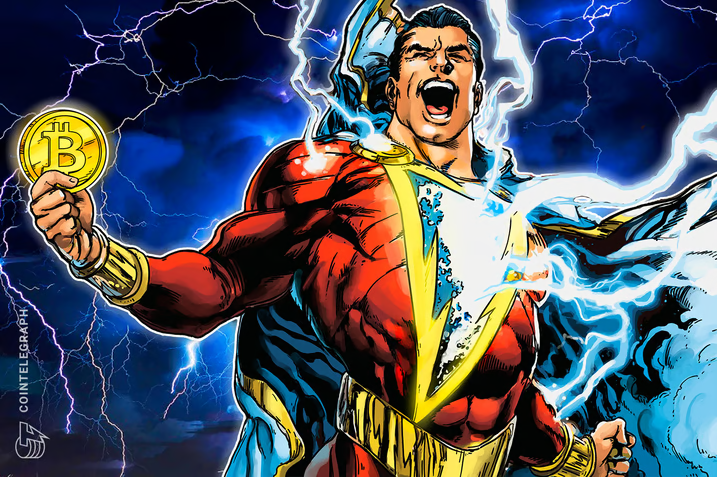
Source: Cointelegraph
The main chain of Bitcoin is like a highway, while the Lightning Network is like a toll-fast channel built next to it. Its core concept originates from compromise on the efficiency of main chain transactions: since there is a speed bottleneck in the on-chain transactions, we no longer focus on recording every transaction on the chain, but instead realizes high-frequency accounting by establishing an exclusive "payment channel" between users, and finally only synchronizes the fund status when the channel is closed to the blockchain. This model is similar to the settlement method of taking turns treating guests between friends every week - people do not transfer money immediately after each meal, but settle accounts in one go after accumulating ten purchases. The Lightning Network is essentially a transaction network woven from tens of thousands of such payment channels.
However, this seemingly exquisite system exposes multiple dilemmas in practical applications. First of all, there is a high threshold for channel construction. Users need to pre-lock funds to establish a transaction channel, which means that if you want to trade with any object, you must establish a dedicated channel connection in advance. The second is the complex routing problem. When users A and B lack direct connection channels, even if there is an indirect path to ACB, if the intermediate channel is insufficient funds or the path node is unavailable, the transaction will still fail. What is even more serious is the security risk. The system requires users to stay online to prevent counterparties from submitting expired transactions to commit fraud when the channel is closed, which poses an unrealistic requirement for ordinary users' equipment operation and maintenance capabilities.
Although Lightning Network has been online for many years, these structural flaws have made it difficult for its practical application to break through bottlenecks. Public data shows that the current lock-in amount of funds of the entire Lightning Network has only maintained at about US$100 million, and its ecological status is almost marginalized compared to the trillion-level market value of the Bitcoin system. This can't help but cause the industry to think deeply: Can we build a more complete off-chain payment agreement to break through the existing dilemma?
According to Link Catcher on April 15, HSBC disclosed in its official press release that Bitcoin Thunderbolt is the most landmark technology upgrade for Bitcoin in the past decade. Thunderbolt's overall observation is more like "Lightning Network 2.0", but it is not only an upgrade, but more like a reconstruction of the off-chain Bitcoin interaction paradigm.
3. What is the Thunderbolt protocol?

Source: Nubit | Bitcoin Thunderbolt
Bitcoin Thunderbolt is a soft fork upgrade method based on the basic layer of Bitcoin. It does not rely on the compromise solution of the second layer network or cross-chain bridge, but directly changes at the protocol level of the Bitcoin main chain, fundamentally improving Bitcoin's scalability, transaction performance and programmability.
From a performance perspective, Nubit has achieved significant optimization of the traditional transaction processing model of Bitcoin with the help of UTXO (Unspended Transaction Output) Bundling technology. Due to the single UTXO model, the transaction speed and throughput are significantly limited. UTXO Bundling allows multiple UTXOs to be aggregated together for processing, which is equivalent to compressing the transaction data volume, thereby increasing the transaction speed by about 10 times without sacrificing security.
In terms of programmability, Bitcoin Thunderbolt is reintroduced and extended the OP_CAT opcode (which was originally present in an earlier version of Bitcoin and was later removed). OP_CAT allows data connection operations, allowing developers to build more complex script logic to directly implement smart contracts on the Bitcoin main chain. The most direct benefit of this upgrade is that developers can deploy decentralized applications (dApps) on native Bitcoin networks without relying on sidechains, Rollup or cross-chain bridges.
At the integration level of asset agreements, Nubit advocates and implements a unified standard called Goldinals. Goldinals It provides an asset issuance framework based on zero-knowledge proof and state commitment. Simply put, this is a set of "bitcoin native" token standards. It does not rely on external trust institutions and does not require complex cross-chain bridges to verify the existence and status of each token on the chain. BitMM's on-chain automatic market makers running on Bitcoin integrate scattered protocol assets such as BRC-20, Runes and Ordinals. Nubit also has important breakthroughs in trustless transactions. Its BitMM (Bitcoin Message Market) system supports users to conduct trustless transaction matching and information verification on the Bitcoin chain.
Unlike traditional expansion ideas (such as using sidechains, Plasma, Rollup, or bridge packaging tokens), Nubit adopts a "mainchain native expansion" path. BitVisa provides a decentralized identity and credentials system. Whether it is transaction compression, smart contract support, or asset standard integration and on-chain transaction matching - they all run directly on the Bitcoin main chain. Native BTC is used instead of cross-chain mapping tokens.
3.1 Analysis of core mechanisms
The content of this chapter is explained in the article "Stateless and Verifiable Execution Layer for Meta-Protocols on Bitcoin" (see Reference Link 1). According to personal understanding, Bitcoin Thunderbolt is similar to Bitcoin Lightning. They are both expansion solutions proposed to solve the problem of slow Bitcoin main chain transaction confirmation. The core goals are to improve efficiency and reduce costs. The difference between the two is:
-
Lightning Network is designed to prefer a "payment channel" - it can only be used for transfer payments, does not support smart contracts or complex logic, and its construction and maintenance threshold is high, which is not conducive to large-scale popularization.
-
Launched by Nubit, Thunderbolt is committed to providing off-chain protocols with programming capabilities, supporting Turing's complete operations, and building more complex state assets, liquidity protocols and financial applications.
Flexible and adjustable multi-party signatures
Imagine breaking a bitcoin “signature” in half: half in Alice’s hands and half in the hands of the committee. Every time they transfer to a new user, Alice and the committee each "add a little secret" to their half signature - only the new user who receives it knows the secret. The recipient can "spoke" the two halves back with the little secrets they know and get a complete signature without Alice talking to the committee online.
Asynchronous fault tolerance committee ledger
A "service team" composed of several nodes (such as 4n+1) is responsible for accounting, and everyone confirms who is the current owner. Even if a few nodes are broken, as long as most are still online, the ledger can be kept running normally. These nodes only care about "helping for signatures" and "accounting", and cannot use funds casually, ensuring security and decentralization.
Atomic interchange finalization
When you really want to spend this money on the chain, you will first go through three steps of "atomic swap": 1. The Alice+ Committee spends the original lock output and temporarily gives the money to the committee; 2. The committee locks the same amount into a safe that can only be used by "Zenni and the committee" together; 3. Finally, Zenni takes away the money in the safe with two signatures. In this way, neither Zenni nor the committee can sneak out, ensuring that off-chain reconstruction and on-chain redemption are completed in one go.
3.2 Thunderbolt's protocol design and key innovation
-
Non-interactive and recursive signature commission designed a set of Tweakable threshold Schnorr signature structure. Traditional payment channels often have to go back and forth several messages. Thunderbolt only needs to "send a signature with a small secret" every time, and even the online requirements are greatly reduced.
-
Change to "new lock" every time you transfer
During each jump, Alice and the committee updated their signatures with a new little secret, and the old "lock" was completely invalidated. In this way, no one before can get the new signature, preventing the old signature from being reused. -
Only traces are left on the chain once, and only one "lock" is put on the chain at the beginning. All subsequent changes are completed off the chain, and finally the money is spent on the chain. Compared with Lightning Network, it is necessary to switch channels continuously, Thunderbolt has fewer on-chain operations and better privacy.
-
You won’t lose money offline, even if Alice or Zenni is offline, as long as the committee is mostly online, you can complete transfers or redemptions at any time, without worrying about the time lock expires or the opponent maliciously closing the channel.
-
All the key steps in the true "machine proof" security protocol are "formal verification" with Tamarin Prover, which means that these security guarantees are not only written on paper, but have been tested over and over again by automation tools.
4. What is the difference between Thunderbolt and the existing Lightning
Network Solution?
Let’s take a look at the comparison between Thunderbolt and existing solutions (such as the BOLT protocol, Breez SDK, Phoenix) and see what it has improved.
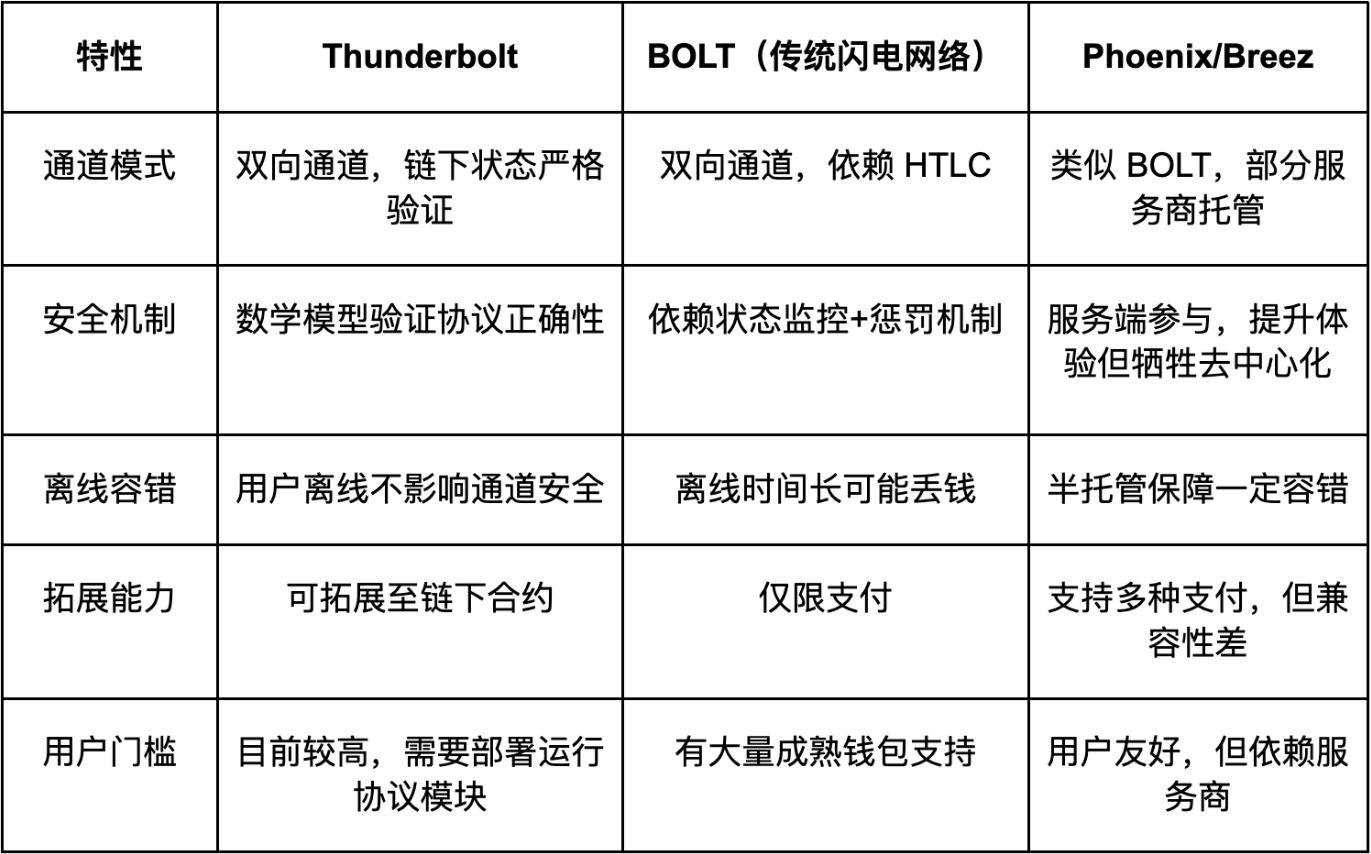
Thunderbolt is different from existing Lightning Network solutions:
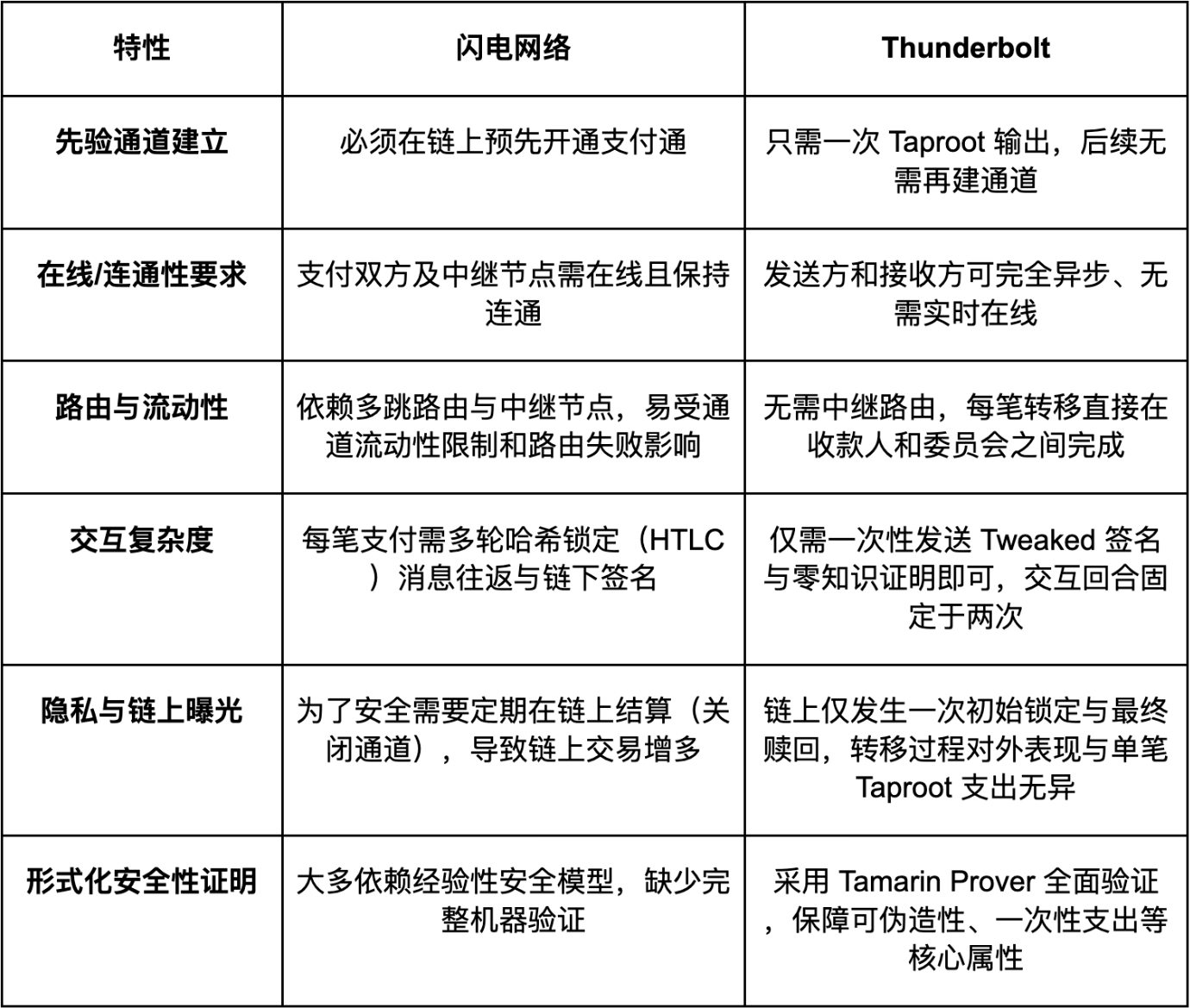
We can see that Thunderbolt's main advantages are reflected in "security" and "theoretical completeness". It's one of the few that can do:
-
Protocol design can be proven to be safe
-
Malicious users cannot make unilateral profits in any state
But its disadvantages are also obvious:
-
Complex deployment : To use Thunderbolt, you have to run the full protocol stack at present, which is difficult for ordinary wallet users to get started
-
Mainchain compatibility : The scripting language of the Bitcoin mainchain is too simple, and Thunderbolt must use smart detours to implement functions, which increases the difficulty of implementation
-
Ecological support is still lacking : Unlike BOLT, which already has a large number of wallets and node support, Thunderbolt is still in the "early research stage"
5. The potential impact of Thunderbolt: the catalyst for BTCFi?
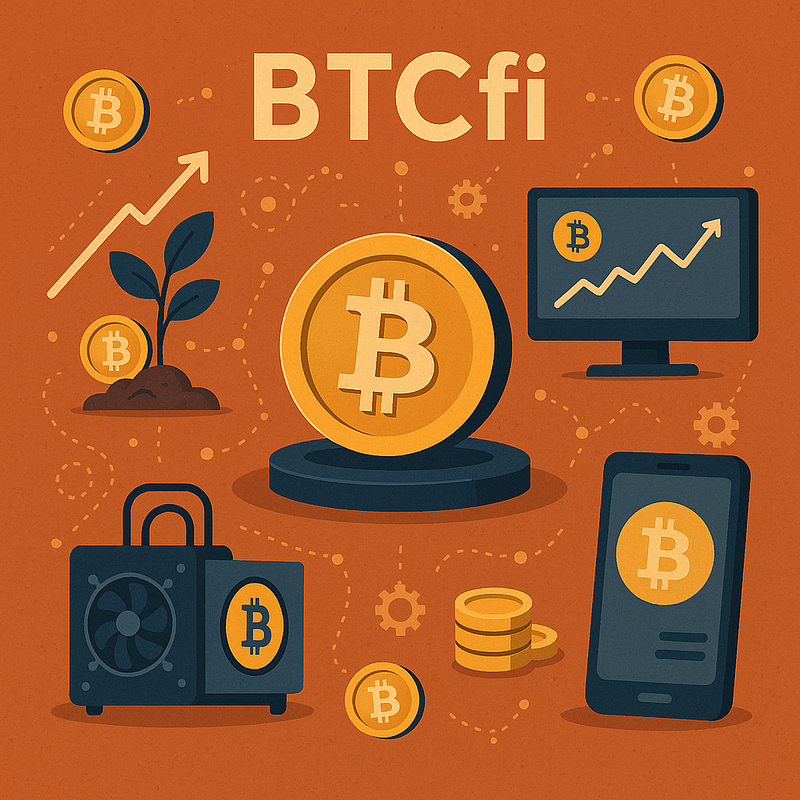
Source: Homemade
So is Thunderbolt the optimal solution to BTCFi? Let's put forward a bold point:
Thunderbolt is the theoretically optimal solution for BTCFi, but it is still in the "alpha stage in practice. In other words, it is like the "Ethereum 2.0 White Paper" in the Bitcoin world, full of vision but has not yet entered the "engineering system level". From the current observation, I personally believe that Thunderbolt has three possible development paths:
1. Rollup integration: as the DeFi engine on the Bitcoin side
The Bitcoin main chain itself is not scalable enough, and Thunderbolt may eventually become an off-chain module on some Bitcoin L2 (such as BitVM, Nomic, BOB). This is similar to "integrating Thunderbolt as a general contract execution layer in Rollup".
for example:
-
BOB can integrate Thunderbolt channel layer to realize native BTC transactions
-
The RGB ecosystem may also introduce Thunderbolt state management logic
-
BitVM itself supports more complex logic, and Thunderbolt will become one of the contract standards.
-
Services Babylon, Bitlayer and other systems
2. Form an independent standard ecosystem and run parallel to the main chain
Thunderbolt's biggest possibility is to develop its own network ecosystem, node operation and maintenance system, aggregators, etc. like Lightning Network, and even form Thunderbolt-LSP operators. At the same time, Nubit, in conjunction with the soft fork upgrade of the protocol layer promoted by Nakamoto's era miners, introduced two major features: UTXO Bundling and OP_CAT, and can also directly undertake BTC protocol assets (BRC20, Runes, and Ordinals), which will create a very large imagination space here. Perhaps in the future it may have:
-
Thunderbolt Wallet (similar to Phoenix)
-
Thunderbolt Node (light node running channel)
-
Thunderbolt DEX (Chain Order Matching)
-
Thunderbolt AMM (Liquidity Pool)
3. Replaced by a simpler solution
Of course, if a system that can achieve similar functions without state channels, formal language, and off-chain protocol collaboration appears in the future, then Thunderbolt may be just a phased transition product, such as:
-
If BitVM implements a more efficient contract execution environment
-
Cross-chain ZK technology enables BTC assets to be fully trustworthy on other chains
-
A native Bitcoin protocol will model payment + lending + contracts uniformly
Finally, from an ecological perspective, the biggest significance of Thunderbolt is not that it can run payments, but that it allows Bitcoin assets to have "off-chain contract composability" for the first time. This sounds abstract, and you can see how critical this "composibility" is from the DeFi outbreak of Ethereum. The outbreak of Ethereum is due to the full ecosystem of Solidity + Hardhat + Ethers.js + Metamask.
The biggest highlight of Thunderbolt is that it introduces two major features: UTXO Bundling and OP_CAT. OP_CAT introduces native programmability for Bitcoin's network. UTXO Bundling (bundling) bundles multiple small transactions together to process, compresses the scale of transaction data, improves on-chain throughput, and the logic is similar to Ethereum Rollup. It seems that unifying all Bitcoin ecological protocols and inclusive of various assets and BitMM implementations is no longer empty talk, but Thunderbolt is still like "written a strong math paper" at this stage, and the overall situation may be quite far from "using" developers.
Reference link:


 jinse
jinse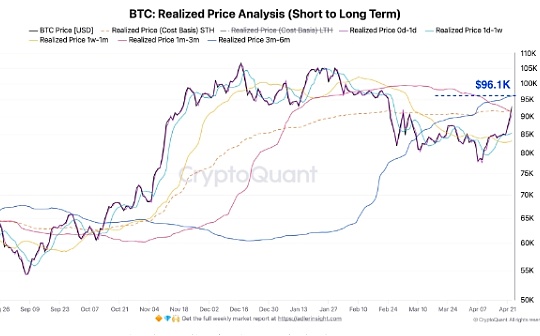

 chaincatcher
chaincatcher